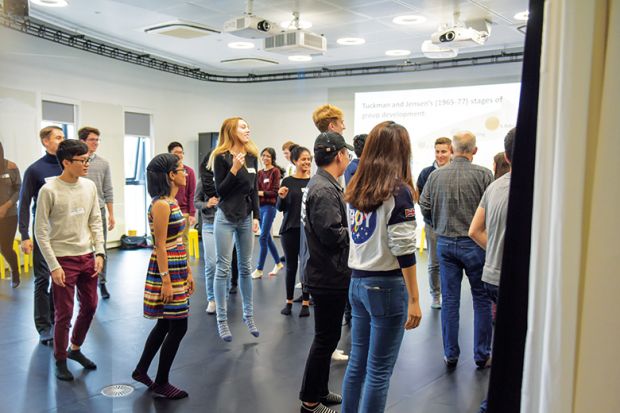Ask anyone which university courses require students to take off their shoes before entering the room, and they will more often than not plump for dramatic arts programmes.
Few people would even consider an executive MBA or a master’s in human resource management and employment relations.
A surprise is in store, therefore, at Warwick Business School (WBS), where one of the key learning environments is a purpose-built sprung-floor drama studio known as the Create Space.
“Coming in here, the physical change of ‘shoes off’ and different conditions, immediately brings you into a different way of thinking,” Piers Ibbotson, principal teaching fellow at WBS, told Times Higher Education.
“You cannot not think differently. Just the strangeness of walking around in bare feet…you’re already taking people away from the possibility [that] they’re going to drop into their usual way of thinking of: ‘I’m a business student, I know a bit of stuff, they’re the lecturer, they know a bit of stuff, we’re going to have a conversation.’
“We’re looking to see what we can access through this space [in terms of] some of the more subtle and ambiguous areas such as aesthetics, ethics [and] behaviour. We can [gain insight into those areas] in a way that you can’t just gather in a lecture.”
Mr Ibbotson, a former Royal Shakespeare Company director, teaches modules at undergraduate and master’s level such as those titled “acting responsibly” and “leading for innovation”. His classes, in the Create Space, are designed to make students more creative and innovative business leaders.
Along with the sprung floor, the room is devoid of furniture, save for a set of lightweight stools. This is designed to encourage new forms of collaboration between students.
Students can act out case studies, and learn “presence”, presentation skills, and how to “act” like a leader. In some cases, students use scenes from Shakespeare’s works and Greek tragedies to understand more about business leaders.
“Previously, teaching innovation has been challenged by traditionally designed teaching and learning spaces, with staff seeking open space elsewhere on campus or having to push back chairs and tables in existing seminar rooms,” said Jonothan Neelands, associate dean for creativity and professor of creative education at WBS. “[The space recognises] social and embodied learning as a valuable and necessary source of meaning-making and understanding.”
WBS dean Andy Lockett argued that, across higher education, the “days of simply standing in front of people and lecturing them are [becoming] increasingly redundant”. Therefore the sector must continue to “think of new ways to engage and facilitate students’ learning”, he said.
“Over and over again, my experience tells me [that] when you talk to graduates [about] their careers, they come back and they talk about how interesting things were and how it took them time to realise, and fully understand, what they’d learned through their education,” Professor Lockett said. “We’re not teaching people in blocks of time and then it stops.
“Hopefully, that learning should go on over time [and] part of the process that uses these more creative interventions is to open that up. Hopefully, that will run and run throughout their careers.”
While the Create Space was conceived in the business school, requests from other departments to use it occur regularly, Professor Lockett added. He argued that this was a sign of the way that Warwick’s relative youth as an institution made it easier to integrate new types of teaching.
“There’s a restlessness about thinking of new ways of doing things, and a willingness to...challenge convention and think of a completely different way of teaching something,” he said.
“We haven’t got the baggage of four or five centuries of history. Warwick’s had to pull itself up from its bootstraps from the very beginning, and that endless pursuit of quality and excellence, and the ability to rethink existing ways of operation, has been part of the [university’s] success.”
POSTSCRIPT:
Print headline: Shoes off! Now let’s discuss details of business strategy
Register to continue
Why register?
- Registration is free and only takes a moment
- Once registered, you can read 3 articles a month
- Sign up for our newsletter
Subscribe
Or subscribe for unlimited access to:
- Unlimited access to news, views, insights & reviews
- Digital editions
- Digital access to THE’s university and college rankings analysis
Already registered or a current subscriber? Login








